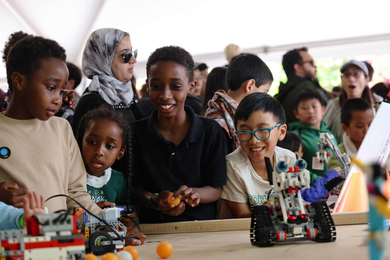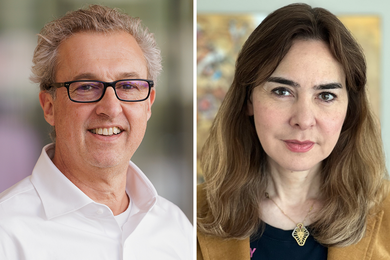The Web is awash with conspiracy theories about voting machine hacks and trickery. And with the midterm elections approaching, even many mainstream politicians are voicing concern about ensuring that every ballot will be counted correctly on Election Day.
But, as an upcoming conference at MIT will show, efforts to ensure the integrity of the American electoral system must begin long before the polls open.
The Voter Identification/Registration Conference, sponsored by the Caltech/MIT Voting Technology Project, to be held Oct. 5-6 at MIT, will delve into the crucial issue of how to effectively register and/or identify voters so they will be able to walk into their polling places and cast ballots efficiently and securely.
A host of nationally recognized experts, academics and researchers are scheduled to participate, including Paul S. DeGregorio, chairman of the U.S. Election Assistance Commission, who will give the keynote address; Marc Rotenberg, executive director of the Electronic Privacy Information Center in Washington, D.C.; Spencer Overton, professor at George Washington University Law School, who specializes in voting rights and campaign finance law; Al Ater, the Louisiana secretary of state; Doug Chapin, director of electionline.org; Anne McGeehan, director of elections for the Texas secretary of state's office; Tova Wang, Democracy Fellow at the Century Foundation; and R. Michael Alvarez, co-director of the Caltech/MIT Voting Technology Project and professor of political science at Caltech. MIT President Emeritus Charles Vest will welcome participants.
"In the 2000 election, we found that two to three times as many errors were caused by registration than by any other problem,'' said Ted Selker, MIT Media Lab associate professor and co-director of the Caltech/MIT Voting Technology Project, which was launched in December 2000 to promote new technology for elections. Â "Two to three million voters were lost in 2000 because of registration issues."
Indeed, key sections of the Help America Vote Act of 2002 focused on registration reforms, Selker said. For example, as of Jan. 1, 2006, all states were required to have a statewide registration database available. The goal, purportedly, is to help local election officials ensure a person is not registered more than once or that someone who should not be registered is kept off the rolls.
However, Selker said, improvements may actually disenfranchise some people, deliberately or by bureaucratic bungling. Selker cited a recent case in California in which people who had recently moved were in danger of being kicked off the rolls because of differences in their addresses between voting databases and motor vehicle license records.
The first day of the two-day conference will focus on such registration issues; speakers include Alexander Keyssar, professor of history and social policy at Harvard's John F. Kennedy School of Government; Jonathan Nagler, professor of politics at New York University; and Stephen Ansolabehere, MIT professor of political science.
"Voting has to be addressed in a multidisciplinary way," said Ronald L. Rivest, the MIT Andrew and Erna Viterbi Professor of Electrical Engineering and Computer Science, who will moderate several conference panels. "Voting is not a simple problem. The constraints and the requirements of voting are tough. You're trying to make sure the votes are actually private but that the voter can verify that (his or) her vote really is accounted for in the final tally--really contradictory requirements.''
Of special interest are "poll books," or portable information databases brought into polling places, and how they would be used. "We hope we will help the Election Assistance Commission think about what would be a good direction forward in a world where registration has in some sense gotten more systematized and how to look at unintended consequences of the new laws on registration and what should be done in future, especially considering other changes to technology," Selker said. "The biggest one I'm thinking about is poll books, that is, having access to registration databases as opposed to just having a list, a page, a piece of paper."
The second day of the MIT conference will focus on whether a system of voter identification, such as a voter ID card, can or should be adopted, as some have proposed.
"A lot of people in this country are worried about that because it's very costly and it can be used in various ways,'' Selker said. "For example, I just spoke with the Pakistani government last week; they said fake IDs account for 5 to 10 percent of the voting in Pakistan. That's pretty bad. So it can go either way, as a lot of these things can.''
Speakers on voter ID include Jonathan Katz, professor of political science at Caltech, and Eric Fisher, senior specialist in science and technology at the Library of Congress. Dan Greenwood, MIT Media Lab lecturer, will speak on "Real ID," a "hugely controversial" proposal that all Americans get identity cards, Selker said. "We're all intrigued."
The last panel of the conference will feature Ross Underwood of Diebold and Howard Cramer of Sequoia Voting Systems. Voting machine makers--and Diebold in particular--have come under scrutiny over security issues.
While voting machines may be the latest wrinkle in election concerns, registration and voter eligibility have been issues throughout U.S. history, as debates raged over whether the right to vote should be determined by property ownership, race, sex or competency. While America wishes to be a beacon of democracy, this country has the world's most complex voting process, Selker said. "We are not the example of the best voting practice."
Rivest welcomed voting controversy as a way to open debate on improvements.
"One realizes that the voting system we have in this country is full of vulnerabilities and we need to pay more attention to improve the quality,'' Rivest said.
For information on the Oct. 5-6 Voter Identification/Registration Conference, go to www.vote.caltech.edu.
A version of this article appeared in MIT Tech Talk on October 4, 2006 (download PDF).





